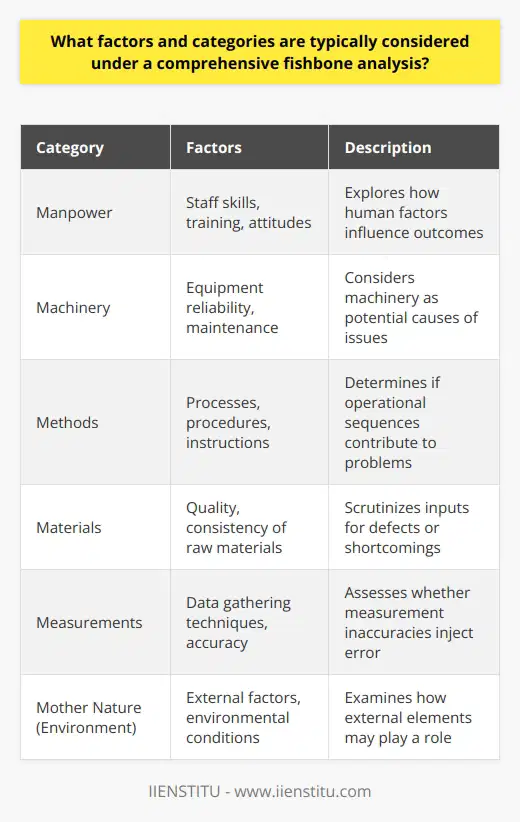
Root Cause Analysis (RCA) is a systematic process for identifying the root causes of problems or events and an approach for responding to them. RCA is based on the basic idea that effective management requires more than merely "putting out fires" for problems that develop, but finding a way to prevent them in the future. It involves investigating and analyzing the patterns of issues to cure the underlying problems comprehensively instead of just resolving the immediate symptoms.
Importance in Problem Solving
Understanding the importance of RCA is critical in any sector where problems could lead to significant consequences. RCA enables organizations to avoid the recurrence of errors, thus improving overall efficiency and reliability. It forms the backbone of continuous improvement practices and is essential to developing strategies that foster long-term success over temporary fixes.
Overview of various Problem Solving Techniques
There are various problem-solving techniques employed across industries to tackle challenges systematically. These include brainstorming, the Five Whys method, and the use of flowcharts to identify interdependencies. However, one particularly effective tool that stands out in its ability to dissect complex issues is the Fishbone Diagram, developed by Dr. Kaoru Ishikawa, which has a profound legacy in the arena of problem-solving.
You can listen to this text instead of reading it.
The Birth of Fishbone Analysis
Origin Story: Dr. Kaoru Ishikawa and His Legacy
Fishbone analysis, also known as cause and effect analysis, was conceptualized by Dr. Kaoru Ishikawa in the 1960s. A renowned Japanese quality control expert, Ishikawa believed that organizational problems could be solved only if the root causes were identified. His dedication to quality improvement processes led him to develop a diagram that resembles a fish skeleton, which systematically categorized causes of problems for better analysis.
Conceptual Understanding: What is a Fishbone Diagram?
The Fishbone Diagram is a visual aid that provides a structured method to explore all the potential underlying causes of a problem. The diagram helps teams to categorize thoughts during brainstorming sessions, making it easier to identify and tackle the root causes. It is an intuitive method that graphically displays the relationships between a problem and its various causes.
The Synonymy of Fishbone Diagram and Ishikawa Diagram
Despite having originated with different labels, the Fishbone Diagram and Ishikawa Diagram refer to the same analytical tool. The term "Fishbone" is derived from the diagram's visual shape, while the name "Ishikawa" honors its creator. Regardless of the name, the diagram's purpose remains unwavering—to delve deep into the causes of a particular issue to find robust solutions.
Understanding the Fishbone Diagram
The Layout: A Visual Representation
The Fishbone Diagram is marked by its characteristic layout which includes a central line leading to a problem statement, with various "bones" that branch out, representing different cause categories. This arrangement mimics the intricate structure of a fishbone, with each bone aligning to a specific aspect of the problem.
Components of the Diagram
The Head: Defining the Problem
The head of the Fishbone Diagram encapsulates the problem at hand, clearly stated and defined. This definition sets the scope for the subsequent analysis and is critical in keeping the team focused on the current issue.
The Bones: Categories of Causes
The bones extending from the main line denote the different categories of underlying causes. The categorization enables teams to approach the problem from multiple angles and sectors, thus ensuring a thorough examination of all possible factors.
The Standard Categories (The Six Ms)
Traditionally, six standard categories, known as the Six Ms, are included in the Fishbone Diagram:
1. Manpower: Considering the human factor, including skills, training, and staffing.
2. Machinery: Reviewing technology and equipment-related issues.
3. Materials: Examining the quality and consistency of materials used.
4. Methods: Analyzing the processes and procedures in place.
5. Measurement: Assessing the systems of measurement and data accuracy.
6. Mother Nature (Environment): Taking into account environmental factors that may influence the problem.
Conducting a Fishbone Analysis
How to Set Up a Fishbone Diagram
Setting up a Fishbone Diagram involves first identifying and clearly articulating the problem. Once the problem is stated at the "head" of the fishbone, teams then brainstorm all possible causes, which are grouped into the major categories and displayed along the "bones" of the diagram.
Engaging the Team in Brainstorming Sessions
Engaging a diverse group in brainstorming sessions fosters a collaborative environment where team members contribute their expertise and perspectives. This collective intelligence is essential in surfacing all potential causes which might otherwise be overlooked by individuals.
Documenting All Possible Causes
It is vital to document every potential cause that surfaces during these brainstorming sessions. No suggestion is too small or far-fetched to record, as even seemingly trivial factors can play a role in leading to the larger problem. By documenting all possibilities, teams can ensure a comprehensive analysis.
Comprehensive Definition Of Logistics And İts Role İn Business
Practical Techniques İn Descriptive Statistics For Data Analysis
Examining Relationships among Causal Factors
Once all potential causes are listed, examining their relationships is the next step. Understanding how various factors interconnect can help in pinpointing the root causes and addressing them in a way that effectively mitigates the problem.
Practical Applications and Benefits
Industries and Sectors Utilizing Fishbone Analysis
Fishbone Analysis has proven beneficial across a wide spectrum of industries, including manufacturing, healthcare, and service sectors. Its versatility allows it to be adjusted to fit the needs of any business or organization seeking to improve their problem-solving capabilities.
Case Study: Real-world Example of Fishbone Analysis in Action
Consider the case of a manufacturing company facing recurring equipment failure. By applying Fishbone Analysis, the team was able to categorize possible causes, which led to the discovery that inadequate training in machinery operation was a significant contributor to the problem. With targeted solutions in place, the company saw a marked reduction in equipment downtime and associated costs.
Advantages of Fishbone over Other Analytical Methods
The advantages of Fishbone Analysis lie in its collaborative nature and its comprehensive scope. Unlike some methods which may only skim the surface of complex issues, the Fishbone diagram encourages in-depth exploration and visually clarifies the relationship between different causes and the problem, thus allowing for more effective resolution strategies.
Common Pitfalls and How to Avoid Them
Avoiding Overgeneralization
One pitfall in conducting Fishbone Analysis is the tendency to overgeneralize. To avoid this, teams must be meticulous in defining specific causes rather than just listing broad problem categories. This specificity will lead to more accurate identification of root causes and more effective solutions.
Ensuring Comprehensive Evaluation
Another common mistake is failing to conduct a comprehensive evaluation. Teams should resist the urge to rush the process, ensuring that each cause is thoroughly examined and its impact assessed. Only with a meticulous approach can all significant factors be addressed.
Maintaining Objectivity in Analysis
A critical aspect to successful RCA through Fishbone Analysis is objectivity. It is imperative to ground each brainstorming session and cause assessment in factual data and to avoid biases that could skew results. By remaining objective, teams can ensure a fair and accurate analysis.
Beyond Identification: Addressing the Root Causes
Prioritizing Identified Causes
After identifying possible root causes, it is crucial to prioritize them based on factors such as impact and feasibility of corrective measures. This prioritization helps in developing a strategic action plan that can effectively address the most significant issues first.
Developing a Strategic Action Plan
Following the prioritization, a strategic action plan should be crafted, outlining the steps necessary to tackle each identified cause. This plan should include measurable goals, responsibilities, timelines, and resources required, thus ensuring accountability and clarity throughout the implementation process.
Ensuring Effective Implementation and Follow-up
The creation of a plan is not the final step; its implementation is equally important. Teams need to ensure that the solutions are actioned accordingly and that follow-up measures are in place to monitor outcomes and make adjustments as necessary. This closes the loop on RCA, solidifying long-term improvements.
Conclusion
Recap of the Importance of Unveiling Root Causes
The Fishbone Diagram is a formidable tool that assists teams in unveiling root causes of problems. It provides a structured way to dissect issues and fosters a shared understanding among team members. Its implementation can lead to profound insights and lasting solutions.
Encouragement to Adopt Fishbone Analysis in Problem Solving
Organizations that embrace Fishbone Analysis can reap the benefits of thorough problem-solving and prevent recurring issues. As a result, they tend to experience higher efficiency, cost reduction, and improved quality in their processes and products.
Final Thoughts on Continuing Improvement and Learning
Continual improvement and learning are pillars of any dynamic business environment. By adopting tools like the Fishbone Diagram for RCA, organizations can foster a culture of continuous learning and ongoing refinement. This mindset not only solves existing problems but also equips teams to better anticipate and mitigate future challenges.
Additional Resources
Suggested Readings and References
For those seeking to expand their understanding of RCA and Fishbone Analysis, numerous scholarly articles, books, and case studies are available. These provide in-depth insights and expand on the nuances of the technique in various contexts.
Workshops and Training on Fishbone Analysis
Hands-on workshops and training can be invaluable for those looking to implement Fishbone Analysis within their organizations. Many of these programs are offered as part of a problem solving course free of charge and can be found through quality assurance organizations and consulting firms.
Online Tools and Software for Diagram Creation
Technology has made it easier than ever to create Fishbone Diagrams, with numerous online mba course platforms and diagramming software available. These tools offer templates and features that streamline the process of creating and collaborating on RCA diagrams, thereby enhancing problem-solving efforts within teams.
Frequently Asked Questions
What is the primary purpose of a fishbone analysis in understanding root causes?
Understanding Fishbone Analysis
Fishbone analysis, often termed Ishikawa diagram, serves a distinct function. It untangles the complexities of root cause analysis. Professionals across various sectors employ this strategy to pinpoint the origins of specific issues.
Purpose of Fishbone Analysis
The primary goal stands clear: identify the root cause. By discerning the underlying problem, one ensures more effective, long-term solutions. This contrasts with the treatment of symptoms, which often leads to short-lived fixes.
Fishbone diagrams facilitate systematic examination. Teams converge, brainstorm, and categorize possible causes. Common categories include Methods, Machines, People, Materials, Measurements, and Environment.
Drill Down to Specifics
This approach mandates specificity. Generalizations obscure true root causes. Thus, participants must detail each potential contributing factor, creating a visual map that highlights complex relationships.
Foster a Collaborative Environment
Collaboration is key. Various perspectives merge, fostering a comprehensive analysis. The fishbone structure levels the playing field, allowing all team members to contribute equally.
Promotes Critical Thinking
Critical thinking thrives in this setting. The diagram encourages asking "why" multiple times. Each "why" probes deeper, navigating closer to the cause.
A Versatile Tool
The fishbone's versatility impresses. It adapts to any industry, any problem. Industry-agnostic, it proves useful in healthcare, manufacturing, and beyond.
In conclusion, fishbone analysis is a powerful method. It roots out underlying issues, champions collaboration, and bolsters critical thinking. As a tool, its primary purpose shines: to illuminate and solve.

How do we interpret the results of a fishbone analysis to drive improvements and solutions?
Understanding Fishbone Analysis Outcomes
Grasping the Basics
Fishbone analysis, or the Ishikawa diagram, untangles complex issues. It reveals underlying causes of problems. Initially, it sketches out main cause categories. These facets may encompass methods, machinery, personnel, and materials. Others include measurement and environment.
Interpreting the Fishbone Diagram
Once filled, the fishbone illustrates potential problem sources. Each branch represents a probable cause path. Analysts study these to find patterns. Frequent occurrences point to significant issues. Here, depth of analysis matters.
Tracing Root Causes
Identifying root causes comes next. Analysts ask "Why?" repeatedly. This technique digs beneath surface reasons. It seeks foundational problems. The objective is not to assign blame. Instead, the goal is understanding.
Prioritizing Issues
After exposing root causes, prioritize them. Some issues weigh more than others. Focus on those with the greatest impact. Consider resource allocation as well. Invest efforts where you can effect change.
Developing Solutions
With priorities set, brainstorm solutions. Look at each root cause. These discussions must involve varied perspectives. Stakeholder engagement is crucial. They know the context best.
Formulating Action Plans
Craft detailed action plans for each solution. Assign responsibilities and timelines. Clear accountability is key here. Without it, plans falter. But remember, flexibility is important. Adjust as new information surfaces.
Implementing Improvements
Take action. Implement the improvements. Monitor progress closely. Use performance indicators. These metrics will gauge success.
Reviewing and Refining
After implementation, review progress. This analysis identifies what works. And, it highlights what doesn't. Use these insights to refine your approach. Continuous improvement is the mantra.
Conclusion
Interpreting fishbone analysis results launches problem-solving initiatives. It demands critical thinking. Clarity in understanding leads to effective actions. Ultimately, this process propels organizations towards greater efficiency and productivity.

What factors and categories are typically considered under a comprehensive fishbone analysis?
Understanding Fishbone Analysis
Fishbone analysis, often termed Ishikawa diagram or cause-and-effect diagram, serves as a systematic approach for identifying potential factors causing quality problems. The diagram visually maps out the various causes linked to a specific problem or effect. Academic and industry practitioners use fishbone analysis across numerous fields to dissect complex issues.
Categories in Fishbone Analysis
The key to a successful fishbone analysis lies in exploring every possible cause. Analysts commonly categorize these into six primary domains, sometimes remembered by the mnemonic 6Ms. These categories often see use in the manufacturing sector and include the following:
- Manpower: This involves human factors. It questions how staff skills, training, and attitudes can influence outcomes.
- Machinery: Here, a focus lies on the equipment used. Analysts consider machinery reliability and maintenance as potential causes.
- Methods: This pertains to the processes and procedures employed. It determines if the instructions and operational sequences contribute to the issue.
- Materials: Under this category, one scrutinizes the quality and consistency of raw materials. It brings to light defects or shortcomings in the inputs.
- Measurements: This area addresses the data gathering techniques. It assesses whether measurement inaccuracies can inject error.
- Mother Nature: This category, also known as Environment, examines external factors. Analysts look at how environmental conditions may play a role.
Other Factors in Fishbone Analysis
Outside of manufacturing, the categories often adapt to fit different sectors. For service industries, the replacement categories, often remembered by the mnemonic 5Ss, include:
- Surroundings: Recalling environment, this studies the impact of the physical setting.
- Suppliers: Supplier relationships and their influence become the focus here.
- Systems: This replaces methods and looks at overarching processes.
- Skills: Dovetailing with manpower, this evaluates employee capabilities.
- Safety: Unique to this analysis, it considers the safety standards and their enforcement.
Advancing a Comprehensive Analysis
Consideration across categories ensures thoroughness. Analysts must engage with stakeholders from every domain. They need comprehensive knowledge of the issue at hand. This collaborative effort helps construct a robust fishbone diagram.
A comprehensive fishbone analysis often includes the following steps:
1. Define the problem: Clearly state the effect or issue under examination.
2. Organize a brainstorming session: Involve a cross-functional team to gather diverse insights.
3. Identify potential causes: Explore causes across the chosen categories.
4. Sub-categorize causes: Breakdown broader categories into more specific sub-causes.
5. Analyze and prioritize: Assess the likelihood and impact of each identified cause.
6. Develop an action plan: From the analysis, formulate strategies to address the root causes.
Final Thoughts
In sum, a comprehensive fishbone analysis spans various categories and factors. These range from human elements to external environmental influences. Analyzing each category ensures a broad and detailed understanding. This approach aids the identification of true root causes. It thereby empowers organizations to devise effective solutions for quality improvement.



